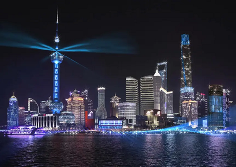Shanghai turning into global shipbuilding powerhouse
The ship, designed independently by Hudong-Zhonghua, is the first of six 24,000-TEU ultra large container ships ordered by Evergreen Group.
Each is 399.99-meter long and 61.5-meter wide, and they are the world's largest container ships with the greatest capacity.
Equipped with desulfuration units, the container ship utilizes state-of-the-art technologies to ensure green sustainability and energy efficiency so as to make the vessel move swiftly and efficiently, with all its performance indicators meeting international advanced standards, Lin said.
Having its focus on building high value-added container ships, Hudong-Zhonghua currently has 19 large-sized container ships under construction, and in 2021 alone, it received orders for 13 units.
As the nation's leader in designing and building large container vessels, Hudong-Zhonghua has so far constructed more than 60 large-scale container ships (above 8,000 TEUs) for global shipowners. Among them, five represented the world's first batch of ultra large liquefied natural gas-powered 23,000-TEU container ships.
Zhou Dequan, director of Shanghai International Shipping Institute's domestic shipping research office, said 2021 was the best year for the global shipping industry since the 2008 global financial crisis.
"This is particularly so for the container ship market, which reached record highs in terms of freight and revenue, and the dry bulk cargo sector, which witnessed the greatest year in the past decade," Zhou said.
Zhou expects the container ship market will maintain forward momentum in 2022, dry bulk cargo will face a mild market adjustment and oil tankers may experience an uptick after the downward correction in 2021.
China took the lead in global shipbuilding by accounting for around half of new ship orders worldwide in 2021, or 965 vessels classed as 22.8 million compensated gross tonnage (CGT), according to British shipping services provider Clarkson.
In 2021, a total of 1,846 such new ship orders were placed across the world, with South Korea accounting for 38 percent, ranking second only to China.
Lin said despite the encouraging progress China's shipbuilding sector has made, there remain challenges for China to overcome before becoming a truly global shipbuilding power.
"Chinese shipyards need to restructure their industrial chain, work hard on their core technologies, pay more attention to design, production and craftsmanship, as well as strengthen their capability in the resilience, flexibility and elasticity of supply chain management," Lin said.
 Contact Us
Contact Us

 Brilliant light show to illuminate Huangpu River
Brilliant light show to illuminate Huangpu River Maple leaves paint splendid scenery in Pudong
Maple leaves paint splendid scenery in Pudong Appreciate alluring lotus blossoms in Pudong's Century Park
Appreciate alluring lotus blossoms in Pudong's Century Park New pedestrian street boosts Pudong's night economy
New pedestrian street boosts Pudong's night economy 


